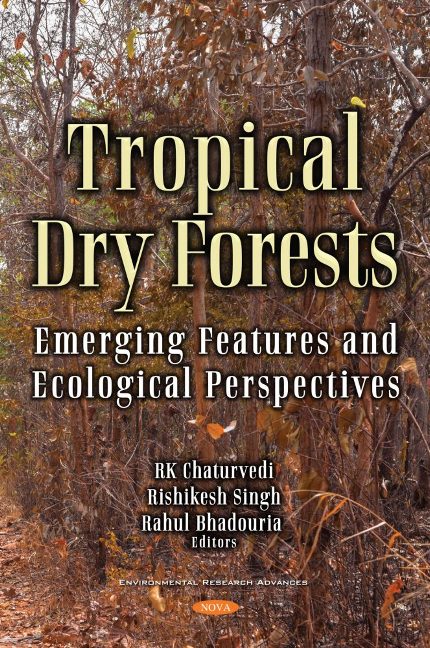
Tropical Dry Deciduous Forests
Emerging Features and Ecological PerspectivesIn Stock
ISBN: 9781536195439
Hardback
477 Pages
Subjects:
The environment

Tropical dry forests (TDFs) constitute one of the most dominant forests, accounting for approximately 45% of all tropical forests. These forests are distributed over an extensive geographical range, spanning large areas of Africa, Latin America, and the Asia Pacific. TDFs occur in severe and extremely variable climate characterized by low annual rainfall and 5-6 months of the dry period within the annual cycle, and nutrient-poor soil. Due to extreme drought conditions, TDFs exhibit deciduousness and various other adaptative features (viz., fire resistance, desiccation tolerance, herbivore defence, high root:shoot ratio, longer seed viability) to establish in the severe environmental conditions, which makes these forests exceptionally critical. These forests are one of the most productive with high biodiversity, but unfortunately, due to persistent anthropogenic pressures in terms of burning, mining, indiscriminate forest cutting, lopping, and increased extraction of non-wood forest products, these forest communities have become one of the most endangered ecosystems. Disturbances in TDFs have resulted in fragmentation and ecosystem conversion, and therefore, these forests exhibit changes in their biomass and productivity. Anthropogenic pressure is rapidly becoming a growing concern globally due to its negative impacts on the structure and composition of the vegetation. In addition, due to their higher net primary productivity, these forests have a considerable effect on the global carbon cycle. Uncontrolled harvesting for gaining temporal benefits is a major cause of forest destruction and deforestation which may lead to major loss. Deforestation and clearing of forests have resulted in soil erosion, soil degradation and loss of biodiversity, socio-economic damages to food components, water and health, as well as the loss of peoples cultural ethnicity. In order to assess the conservation status of TDFs, information is required on its distribution pattern, climate, structural and functional traits of the vegetation, phenology, strategies against drought, nutrient deficiency, and disturbances. This book discusses various issues, obstacles and opportunities for protection, regeneration and management of TDFs worldwide, as well as information gaps in the areas referred to above, which may be of critical significance in adapting and mitigating responses to the current climate change scenario. The book is intended to help in collection of detailed knowledge and to address the concerns from environmental scientists, forestry experts, planners, policymakers and the general public. Starting with a description of plant composition of worldwide TDFs, the book evaluates plant diversity, biomass dynamics, carbon storage, late history and current status of anthropogenic disturbances, distribution pattern of lichen communities, relevance of tree crown architecture, effects of forestry management practices, degradation and traditional land-use practices, impact of changing environment on carbon dynamics, estimating ecosystem services using a geospatial approach, productivity and carbon accumulation, habitat heterogeneity and its impact on organic matter, nutrient pool and nitrogen mineralization, phosphorus and litter decomposability traits. For re-development of TDFs, the book describes improved low-input tree establishment methods, impact of drought and plant mechanisms to mitigate drought stress, importance of serotiny related to delayed seed dispersal, and foraging efficiency of fine roots in relation to carbon dynamics in a changing environment.
We understand the importance of accessibility for all of our customers, including those with disabilities. While our website may not currently meet the Web Content Accessibility Guidelines (WCAG) 2.1, Level AA, we are actively working towards compliance and constantly seeking ways to improve the user experience for all of our customers.
To that end, we have implemented a variety of accessibility tools provided by third-party app, AppifyCommerce. These tools include features such as keyboard navigation, high contrast mode, font resizing, and alternative text for images read focus, various cursor sizes. We have also incorporated tools to help with visual impairments, such as screen readers and text-to-speech functionality.
In addition to these technical solutions, we have also made a commitment to providing clear and easy-to-understand information on our website. This includes using simple and straightforward language, providing alternative text for images and videos, and including clear and detailed product descriptions.
We understand that accessibility is an ongoing effort and that there may be areas of our website that are not fully accessible. If you have any difficulty accessing our website or have any suggestions for improvements, please contact us at [email or phone number]. We will make every effort to respond to your request as soon as possible and work towards resolving any issues you may have encountered.
We also strive to provide equal access to our products and services, including our online store and customer service channels. So, we are always open to feedback, suggestions, and ideas on how we can continue to improve accessibility on our website and in all aspects of our business.
Our ultimate goal is to ensure that all of our customers, regardless of ability, have a positive and seamless experience when visiting our website and purchasing from our store. Thank you for visiting our store and for your patience as we continue to work towards full compliance with the WCAG guidelines.
